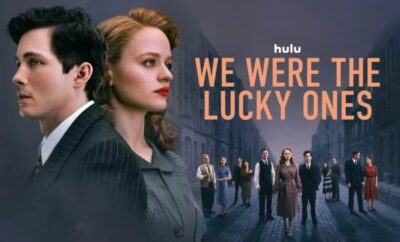Features
Diary Of An Immortal (1945 – 1959)
By: Emma Sterner-Radley
This review will contain some spoilers.
This book is going to ask you to stretch the limits of your understanding of history, religion and the origins of the human race. If you are willing to go along with that, you will be treated to a thrilling adventure with a relatable protagonist, plot twists, ethical quandaries, romance and an antagonist you will love to see punished.
Diary of an Immortal (1945 – 1959) is a mix of historical novel and magical realism. It starts out in the throes of World War II and introduces us to our protagonist who is a young, American soldier and military medic by the name of Steven Ronson. While freeing prisoners from a concentration camp, he comes across a batch of immortality pills. It turns out they were created by a German scientist, using an ancient Chinese formula as base and then perfecting it with western techniques to present it to Adolf Hitler. The pills never reach the Fuhrer, but instead end up in Steven’s hands. His hatred of death makes him start to take them and that changes not only his life, but his place in history as he becomes part of everything from the inner circles of the jazz scene in 1940’s New York to the Chinese Communist Revolution (also known as the 1949 Revolution.)
It leads to a winding, but never long-winded tale where Steven falls in love, gets drawn into conflicts, dies and gets brought back to life repeatedly. He also finds a foe that must be vanquished, has his beliefs altered, has his moral compass tested and obviously learns about life as an immortal.
I like historical novels, but must admit to being a bit weary of World War II themed books after reading far too many horrible accounts that plunged me into sadness for days. However, this one by author David J. Castello didn’t make me want to drown my sorrows in ice cream on page two, despite the dreadful events the book covers. The descriptions of war and of the characters encountered were so vivid that I was immediately captivated – a rare feat as I usually need a good fifty pages before I’m invested. In the first part of this book we get to see the horrors of war, but more importantly the horrors of death, setting up the love affair with immortality nicely.
The functionality of the immortality drug is described in a straight forward and surprisingly believable way and so is the overall concept of it. In general, this book seems to answer a lot of the questions that pop into your head while it lines up incredulous things. It deals with the morality and ethics that come with the decisions that Steven make and it needs to because the plot of this story takes us into murky and morally questionable places at times. Life, death, love, religion and science – everything gets put under the microscope as Steven decides to start taking the immortality pills and becomes a part of important historical events.
Not only does he become a part of key historical events, he also meets and talks to plenty of key historical people like for example Mao Tse-Tung and Dalai Lama. He also meets jazz royalty like Charlie Parker with cameos from Billie Holiday, Dizzy Gillespie and Sarah Vaughan for extra spice. You could imagine this becoming contrived and too clearly the daydreams of an author wishing his character to meet some of his own heroes, but it is dealt with in a surprisingly down to earth way. There is no sensationalism or obvious hero worship as far as I can see yet the real-life characters are still dealt with in a respectful way as to not upset anyone.
What might upset people isn’t the way the story takes liberties with history and famous figures, but how it deals with religion. Buddhism and Christianity get shaken about quite a bit yet other religions don’t get off shot-free either. If you are religious and don’t like the idea of having the basics and main figures of your religion tampered with, perhaps you should give this book a miss. I do hasten to add that no religion is slated or blamed for anything, they are just slightly…reimagined.
Additionally, the immortality formula that Steven takes leads to more than a longer life and a more prominent part in history. He can also open a portal into a sort of force/state of mind when he is unconscious and particularly when he is playing music. The book refers to this force that surrounds us as the “Akashic Records” and in it Steven can see visions of anyone who has ever lived. Anyone who has seen the movie Limitless will recognize the idea of expanding the human mind to see that there is more to this world than what we with our limited view can see and there were scenes in the book that certainly reminded me of the film.
I found that this part made the book lose some of its pragmatism that we had seen surrounding any supernatural elements before but that is a matter of taste. The Akashic Records play an important part in re-imagining how our world is built up so I understand its role in the narrative. There was obviously a lot of work put into that and a lot of research done. In general, no matter what you think of the way the author plays with history – real-life people and religions – you cannot help but be impressed with the amount of research that has gone into this project.
I was also impressed and happy to see the story deal with the east meets west aspect. Much of the book takes place in China and Tibet and the author seems to really want to be respectful of the non-American cultures portrayed in the book. Even through a 1940’s and 50’s point of view we see Castello’s characters point out that you cannot see the actions of a foreign culture through the glasses of your own, but must try to have an open mind and expand your worldview. We see Steven fall in love with much of China and it’s communist uprising, at least until things turn ugly.
I must confess to being less enthralled with the book’s female characters, who are only love interests and not very interesting ones at that. The book doesn’t pass the Bechdel Test (two female characters talking to each other about anything else than a man) and there is actually general lack of women in the storyline. I have to add that the author comes dangerously close to using the much-discussed trope of having a female character raped to further the male protagonists story.
Speaking of possibly triggering plot points, there is a lot of blood and gore in this book and if you cannot read about torture, genocide, rape and graphic violence – this is not the book for you. However, I hasten to add that a lot of books and media out there today is much more graphic and violence-romanticizing than this book is.
All in all, this is a very good read which pulls at the heartstrings and I know it will stay with me for quite a while. I admire the imagination, research and hard work that went into it. The prose was elegant and simple, making you forget that you were reading as you went along. I will remember Diary of an Immortal (1945 – 1959) for managing to be bloody and grim, but yet never make me so uncomfortable that I put the book down – a hard balance to achieve.
Oh and it will surely come as no surprise to anyone who has seen the title of the book that this promises to be part one of a series. If that is the case, I look forward to reading the following books and hope that we will see a few more realistic and important female characters as the story continues. And maybe just a smidge less blood and gore, please?





You must be logged in to post a comment Login